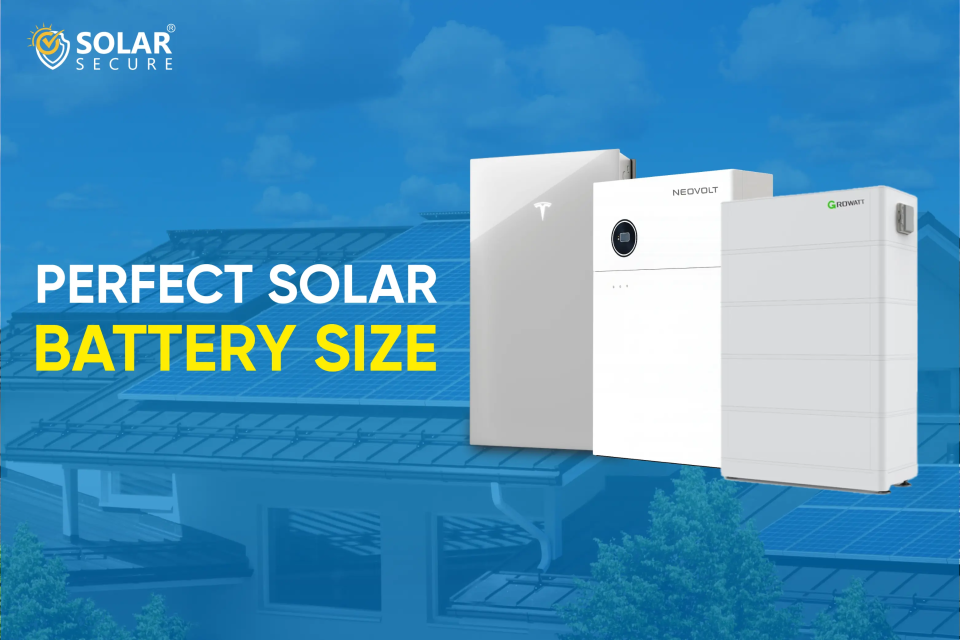One of the most common questions we get at Solar Secure is: “What size solar battery should I get?”
And honestly, it’s a great question because getting it right can make a big difference to your savings, payback period, and overall satisfaction. Go too small, and you might miss out on storing valuable solar energy. Go too large, and you risk overinvesting in storage you never fully use.
In 2025, with new rebates and growing interest in solar battery systems across Australia, finding the sweet spot has never been more important.
This guide will walk you through how to size your battery based on your energy use, solar production, and home setup, so you can make a confident, informed decision.
What Impacts the Right Battery Size for Your Home?
There’s no one-size-fits-all answer to battery sizing, but there are a few key factors that drive your ideal setup:
- 1. Daily Energy Usage : Start by looking at how much power your household uses in a 24-hour period. Most homes consume more energy during the evening and early morning when solar panels aren’t producing, so your battery should be sized to cover that load.
- 2. Solar Panel Output : Your solar system’s capacity matters, too. If you generate a lot of excess solar during the day, a larger battery can help you store more of it rather than exporting it back to the grid at low feed-in rates.
- 3. Energy Goals : What are you hoping to get out of your battery? Some people just want to lower bills, while others want blackout protection or full energy independence. Your goals help shape the system size and features you’ll need.
- 4. Budget and Rebates : Of course, cost plays a role. But with federal and state rebates in place for 2025, including the 30% Cheaper Home Batteries Program, you might be able to afford more storage than you think.
At Solar Secure, we assess all of this before recommending a setup, so you’re never over- or under-sized.
What should I consider when shopping for solar batteries?
1. Capacity & Size vs Your Energy Needs
- Look at how much electricity your household uses daily (kWh), especially in the evening/night when solar doesn’t produce. That helps decide how large a battery you need.
- Check your current solar PV system size, whether you’ll add panels, or if you want the battery to power an EV. These affects required battery capacity.
- Beware of under-sizing (battery runs out too quickly) or oversizing (wasted investment if you can’t use all the stored energy)
2. Usable Capacity, Depth of Discharge (DoD), & Efficiency
- “Usable capacity” means how much energy you practically get out of the battery, not just maximum stored energy. Batteries degrade, and not all stored energy is usable.
- Depth of Discharge (DoD): how much of the battery’s capacity you can use each cycle without harming its lifespan. A high DoD (80-90% or more) is better.
- Round-trip efficiency: you lose some energy when charging and discharging; higher efficiency means less loss.
3. Battery Type & Chemistry
- Lithium-ion batteries are most common for home storage now; many uses Lithium Iron Phosphate (LFP) chemistry which tends to be safer and longer-lasting.
- Other types exist (lead-acid, etc.), but often these have shorter lifespans, more maintenance, or lower efficiency.
4. Warranty, Cycle Life, and Lifespan
- Check the number of cycles (how many full charge/discharge processes) the battery is guaranteed for. More cycles = longer lasting.
- Warranty duration: many good batteries offer 10 or more years, but warranty terms differ (e.g. guaranteed capacity after X years)
5. Safety, Certification & Standards
- Must comply with Australian safety and electrical standards. Use only Clean Energy Council (CEC) approved products.
- Installers/designers must be accredited under Solar Accreditation Australia (SAA)
- Check for past recalls or safety incidents for that model. Fire risk is a real concern with batteries.
6. Cost & Financial Incentives
- Upfront cost-plus installation. Batteries are expensive, so get multiple quotes. Be careful of “too cheap” offers.
- Rebates, subsidies, or government programs can significantly reduce cost. As of July 1, 2025, the Cheaper Home Batteries Program gives around 30% discount on eligible solar batteries.
- Under that scheme, the battery capacity must be between 5-100 kWh (nominal) to qualify, and only the first 50 kWh of usable capacity are eligible for STC rebates.
7. Return on Investment & Payback Time
- Estimate how much you’ll save on your electricity bills versus what you spend buying, installing and maintaining the battery.
- Factor in electricity prices, feed-in tariffs (what you get paid for exporting excess solar energy to grid), and how often battery is used. If you export a lot but get very little back, battery returns are less.
8. Installation, Location & Maintenance
- Access for installation : you need space, ventilation, safety clearances, appropriate mounting and electrical connections.
- Consider the environment (heat, exposure to sun, humidity), battery efficiency and lifespan degrade faster in extreme heat.
- Review maintenance requirements. Some systems allow remote monitoring, periodic servicing etc.
9. Future Proofing & Flexibility
- If you expect your energy use to go up (e.g. buying an EV, more appliances, adding panels), build in margin to accommodate that.
- Some batteries or inverters have capability to join Virtual Power Plants (VPPs) or support two-way flows with the grid. This can allow extra savings or feed-in credits.
Realistic Battery Sizes for Different Homes
Here’s a general guide based on typical Australian household sizes and usage patterns. These figures assume you’ve got a 6.6–10kW solar PV system installed:
| Home Type | Daily Usage | Suggested Battery Size |
|---|---|---|
| Suggested Battery Size | 5–8 kWh | 5 kWh |
| 2–3 Bedroom Home | 10–15 kWh | 7–10 kWh |
| 4+ Bedroom Home | 15–25 kWh | 10–13.5 kWh |
| Home with EV / Pool | 20–30+ kWh | 13.5–15+ kWh |
Remember—this is a starting point, not a rulebook. We tailor our recommendations using live usage modelling and historical energy data, so you get a battery that fits your lifestyle—not just a sales chart.
How Solar Secure Helps You Get the Right Size
Battery sizing isn’t just about kilowatts; it’s about matching storage to your lifestyle.
Here’s how we make it easy:
- We analyse your power bills, roof specs, and solar generation to recommend the ideal size.
- We offer customised quotes with all 2025 rebates applied upfront
- We help you understand how your battery will work and not just what it costs
- We handle installation, monitoring, and support with no hidden fees or hard sells
Whether you’re upgrading an existing solar system or starting from scratch, our team makes sure your investment works hard for you.
Conclusion
Choosing the right solar battery size for your home in 2025 isn’t about simply picking the biggest or most popular option, it’s about finding the perfect balance between your household’s energy needs, lifestyle, budget, and long-term goals. By carefully evaluating your daily electricity consumption, backup requirements, peak usage times, and the solar system capacity you already have (or plan to install), you can determine a battery size that offers the best return on investment.
With advancements in technology and the availability of federal and state rebates, solar batteries are becoming more affordable and efficient than ever. Whether you want to cut down on power bills, protect your home from blackouts, or move closer to full energy independence, the right-sized battery can make all the difference.
If you’re unsure about the exact size you need, consulting with a professional solar installer like Solar Secure is the best way forward. They can tailor recommendations to your home, ensuring you don’t overspend on unnecessary capacity or fall short when you need power the most. In 2025, investing in the right solar battery isn’t just a smart financial decision, it’s a step toward a sustainable, resilient, and future-ready home.





